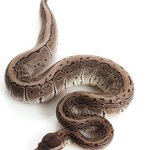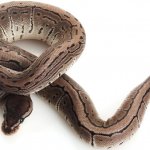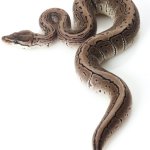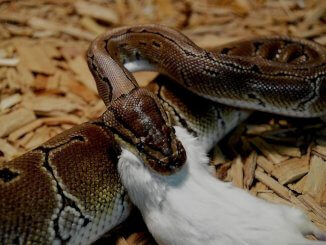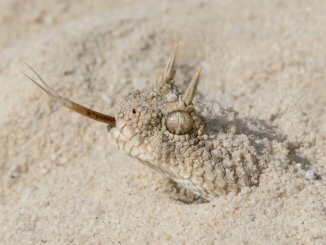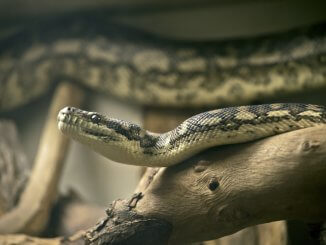Axanthic ball pythons are rare Ball Python color morphs.
Axanthism is a color mutation in snakes. It prevents them from producing yellow pigmentation.
This color mutation produces species that look like a black and white photograph. Axanthic morphs have striking black and white colors.
Many Axanthic Ball Pythons are also bred for different pattern morphs. The most popular varieties are the pied and pinstripe.
If you want to keep this prized morph, keep reading to learn about the different patterns, bloodlines and history.
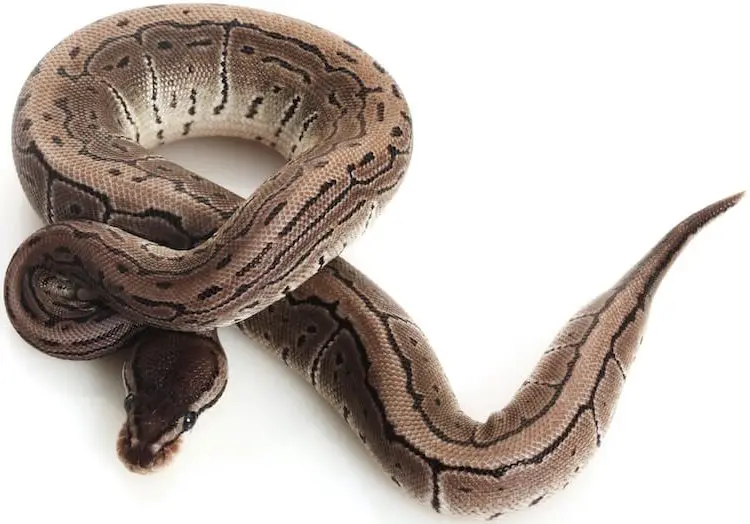
What Is An Axanthic Ball Python?
Axanthic Ball Pythons are a color morph of the Ball Python. Axanthism is a recessive color mutation that reduces the number of yellow pigment-producing cells in a snake.
Pure Axanthic snakes look very similar to a common Ball Python but are just black, white and gray.
The first axanthic morph was bred in 1997.
Most axanthic pythons today descended from one of four bloodlines:
- VPI (Vida Preciosa International – Dave and Tracy Barker).
- Snake Keeper.
- Jolliff.
- Marcus Jane.
Species from the VPI bloodline retain their black and white color throughout their life. The other bloodlines normally develop a brown coloration as they age.
Breeding pure Axanthic ball pythons is very difficult because the gene is recessive. It requires two parents that are either homozygous recessive or heterozygous:
- A pair of homozygous snakes will produce a clutch that is entirely Axanthic.
- The offspring of a pair of heterozygous snakes only have a 25% chance of being Axanthic.
Because of the difficulty in breeding this morph they are very rare. Normally this species is bred with other designer morphs such as the clown or albino.
Axanthic Morph Bloodlines
Most axanthic pythons descended from one of four bloodlines.
VPI
- The VPI bloodline is bred by the Vida Preciosa International breeding organization. This organization is in Texas and is run by David and Tracy Barker. The Barkers were the first to isolate the axanthic gene successfully. They bred their first Axanthic Ball Python in 1997. Unlike the other bloodlines this axanthic python rarely browns out with age.
Snake Keeper
- Snake Keeper is a bloodline first bred by Dan and Colette Sutherland. The Snake Keeper breeding program is based in Utah. They bred their first Axanthic Ball Python in 1999. These morphs tend to brown quite quickly when compared to the other bloodlines.
Jolliff
- The Jolliff bloodline is very rare. Jolliff axanthic pythons were bred in 2002 by Michael Jolliff. They show a reduced patterning and darker overall coloration. Jolliff axanthics are desirable for their unique patterns and dark color.
Marcus Jane
- The Markus Jayne bloodline was bred in 2008 by Mark and Jayne Mandic. These pythons have a slightly different color than the other bloodlines. They are not black and white. Markus Jayne pythons have light silvery sides and pale bellies.
Axanthic Snake Appearance
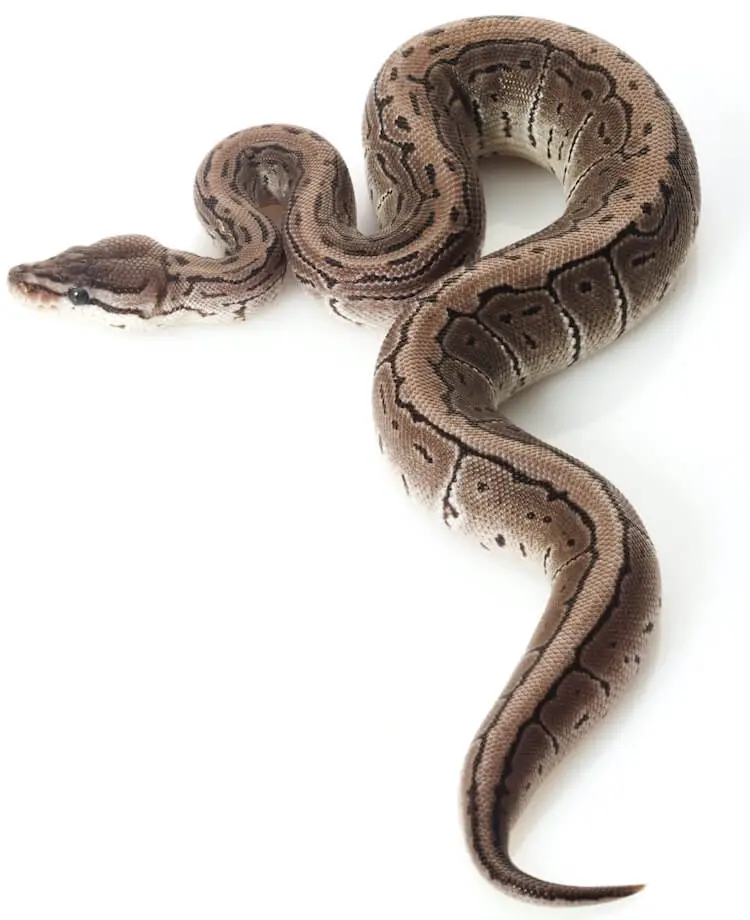
Axanthic Ball Pythons are easily identified by their monochromatic colors. They have the same wild-type Ball Python pattern with shades of black, white and gray.
The Axanthic morph replaces the deep brown color with shades of white, silver and gray.
These colors vary depending on the bloodline and morph quality.
VPI morphs are the most desirable because of their complete absence of brown, yellow and tan. They have white bellies with smooth silver-gray sides that fade to a light silver spine.
Less desirable Axanthic Ball Pythons brown as they age so their pattern becomes less defined.
Axanthic Ball Python Size
Axanthic Ball Pythons can grow to a maximum of six feet in length. Normally females grow three to five feet in length.
Females are generally larger and heavier than males. Males average two to three feet.
Hatchlings are typically around 12 inches long and weigh 49 to 62 grams. This species of snake grows rapidly as a juvenile.
Ball pythons are thick heavy-bodied snakes. They weigh three to five pounds when fully grown.
Types of Axanthic Morphs
Axanthic Ball Python morphs can be bred with other morphs to create unique combinations of traits. It is common for them to be mated with spider, piebald and pastel morphs.
The following is a list of specialized Axanthic Ball Python morphs:
Axanthic Pied Ball Python
Pied Ball morphs are completely white with patches of silver and gray markings. They may have very few patches or a mottled appearance depending on the individual. The best form of this morph has well defined patches with crisp edges.
Pastel Axanthic Ball Python
Pastel Axanthics are lighter in color. They have white bellies and brushed silver sides. They normally have black markings that fade to tan or cream on the spine. The best pastels have minimal shading on the sides and are a uniform light silver with darker markings.
Black Axanthic Ball Python
Black Axanthics are the opposite of Pastels. They are a dark smoky gray. Their markings do not lighten near the spine and they retain their color into adulthood.
Red Axanthic Ball Python
Red Axanthics are a color and pattern morph. These pythons are normally a light reddish cream color. They have a clear stripe down their spine, a light head and alien head patterns along their sides.
Axanthic Spider Ball Python
The Spider is a pattern morph that has thin lines on their back and sides. These lines give the appearance of a spider’s web and replace the traditional dark blotches of wild type Ball Pythons.
Axanthic Clown Ball Python
Clown pythons have a unique pattern that is most prominent on their head. Every clown python has a wide black stripe along their back. Axanthic Clowns are lighter in color than pure Axanthic pythons.
Spider Killer Bee Axanthic Ball Python
This morph is a cross between a Pastel and Bumblebee Ball Python. Axanthic Killer Bee pythons are pure white with gray or lavender stripes and minimal head markings.
Axanthic Bumblebee Ball Python
Standard Bumblebee morphs are bright yellow and white. The Axanthic version has a white underbelly that transitions directly into a light silver. This morph has dark vertical stripes and spots without a dorsal stripe.
Famous Axanthic Morphs
There are also two famous Axanthic morph species:
- Super Pastel Axanthic
- Stormtrooper
Super Pastels have broken gray stripes that fade to white close to the spine and belly. These stripes can range from dark gray brown to pale cream.
The Stormtrooper is a one-of-a-kind morph that was hatched in 2016 by John Dague. It was bred from a Super Pastel and Axanthic and has a pure black and white pattern.
Breeding Axanthic Ball Pythons
The Axanthic gene is inherited through recessive genetics.
This means the Axanthic Ball Python needs two copies of the Axanthic gene (i.e. one from each parent) in order to show the Axanthic coloration.
In order to have a 100% clutch of Axanthic Pythons both parents must be homozygous.
The first Axanthic python was purchased in 1991 by VPI from an importer who captured it in Africa. However buying two homozygous morphs can be expensive.
Some breeders use a heterozygous Axanthic python for one or both parents.
A heterozygous python only has one copy of the Axanthic gene – not two. This means their parent will not show the Axanthic color.
Mating a heterozygous with a homozygous snake gives a 50% chance that a hatchling will inherit both necessary genes and be Axanthic.
Breeding two heterozygous snakes gives a 25% chance of an Axanthic hatching.
Buyer’s Guide
Axanthic ball pythons are a rare morph.
What you look for when purchasing an Axanthic ball python will depend on what you are planning to do with it. If you are just looking for an exotic pet then do not worry too much about bloodline. However, usually people who buy Axanthic pythons want to breed them. That brings up a few extra considerations.
If you are planning to breed this morph then you should decide on the specific traits you want to accentuate. This will help you pick a bloodlines that matches your goal:
- VPI Axanthics are best for preserving silver and gray colors.
- Jolliff pythons are better at retaining unique patterns.
If you are buying an Axanthic Ball Python to breed remember the different bloodlines are incompatible with each other.
It is also possible to confuse some morphs like Super Pastels, Cinnamons and Ghosts for Axanthic Ball Pythons. If you are unsure of a python’s genetics then always ask the breeder rather than assume.
Finally this morph is still undergoing development.
Not every bloodline is available for sale.
The Stormtrooper python is an example of a species whose genetics are unknown and have not been replicated. The Axanthic Firefly was also recently discovered and is very rare to find.
How Much Is An Axanthic Ball Python?
The price of an Axanthic ball python will depend mostly on their pattern.
Prices can range from $300 for a standard Axanthic morph to over $5,000 for a clown or piebald pattern.
| Morph | Price ($USD) |
|---|---|
| Axanthic Pied | $2,000 |
| Pastel Axanthic | $300 |
| Black Axanthic | $1,000 |
| Red Axanthic | $500 |
| Axanthic Spider | $1,000 |
| Axanthic Clown | $6,000 |
| Spider Killer Bee Axanthic | $800 |
| Axanthic Bumblebee | $1,300 |
| Het Red Axanthic | $1,000 |
Summary
The Axanthic Ball Python is a recent Ball Python color morph.
Axanthism is a recessive color mutation that results in black and white snakes.
Species from the VPI bloodline retain this black and white color throughout their life. The other three bloodlines normally develop a brown coloration as they age.
This morph is rapidly growing in popularity thanks to super varieties such as the Stormtrooper and Axanthic Firefly.
The full extent of this morph’s genetics has yet to be discovered.
Are you planning on breeding an Axanthic? Let us know below.

